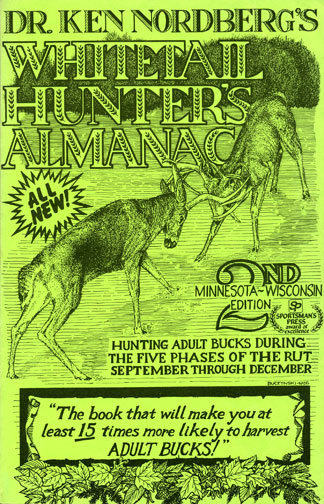 |
 |
 |
 |
 |
 |
 |
 |
 |
 |
 |
 |
 |
 |
 |
 |
Dr. Ken Nordberg's Whitetail Hunter's Almanac 2nd Edition
John Nordberg -- When I read through the Table of Contents for this book, it reminded me of what it was like when Dad came out with this book. No one before had ever defined and explained the Phases of the Rut like Dad did. This knowledge is critical to a Buck Hunter. Other writers tried to discount the information in this book. They failed. This critical information was, and still is, so logical and well thought out that it forever revolutionized Whitetail Buck Hunting. It should form the basis of every hunter's knowledge of whitetails. If you read other writers works and note the date -- pre or post 1989 -- you will understand how important this book is. I know it might be frustrating that it is currently out of print. If you can find a copy on eBay, snap it up. There is so much in here, my To-Do List now states I have got to re-read my copy.
Title: The WhiteTail Hunter's Almanac 2nd Edition
Author: Dr. Ken Nordberg
Most Recent Price: $9.95
First Copyright Date & Printing: 1989
Number of Pages: 151+
Table of Contents:
Forward
Author's Introduction
Chapter 1: Where to Hunt
Rut Phases and Buck Locations
Scouting Guidelines for Hunting Adult Bucks
Chapter 2: Rut Phase I -- The Development Phase
September 1st -- Onset of the Rut
Velvet Shedding
Velvet Rubs
Neck Enlargement
Musk Production
Sperm Production
Increasing Aggression -- Sparring and Battling
Phase I Buck Movements
Hunting Bucks During Rut Phase I
Scouting
How to Identify a Buck Bedroom During Early September
Buck Bedroom Stand Placement
How to Hunt a Buck Bedroom During Phase I
How to Identify a Phase I Buck Feeding/Sparring Area
Buck Feeding/Sparring Area Stand Placement
When to Hunt a Buck Feeding/Sparring Area During Phase I
How to Identify a Buck Watering Site
Watering Site Stand Placement
When to Hunt Watering Sites
White Oak Acorns
Scouting Oaks
Oak Stand Placement
How and When to Hunt White Oaks
The Multi-Stand Approach
Rattling
Calling
Buck Musk
Doe Urine Containing Doe-in-Estrus Pheromone
Chapter 3: Rut Phase II -- The Breeding Range Establishment Phase
The Triggering Factor
Sizes of Breeding Ranges
Staking Out Breeding Ranges
October Antler Rubs
Rub Diameters vs Buck Sizes
Antler Rub Sites
Scalp Musk
Ground Scrapes and Why Bucks Make Them
How Ground Scrapes are Made
Yearling Buck Scrapes
Lesser Adult Buck Scrapes
Dominant Buck Scrapes
Why Scrapes are Abandoned
Breeding Range Establishment
Lesser Buck Temporary Ranges
Hunting Bucks During Phase II
Scouting
More on Identifying Dominant Buck Ground Scrapes
Hunting Dominant Buck Ground Scrapes
Scrape Site Stand Placement and Preparation
When to Give Up on a Scrape
Using Lures At Scrapes
Using Lures at Dominant Buck Bedrooms During Phase II
How to Find and Recognize Phase II Temporary Ranges
Temporary Ranges -- Stand Placement and Preparation
Using Lures at Lesser Buck Temporary Ranges
Effect of Unseasonably Warm Weather During Phase II
Chapter 4: Rut Phase III -- The Primary Breeding Phase
Rut Phase III Dates
Breeding Behavior -- Does
Breeding Behavior -- Antlered Bucks
Buck Avoidance and Escape During Phase III
Rage Rubs and Rage Scrapes
Adult Doe Bedding Areas
Scouting
Stand Placement
How and When to Hunt Adult Doe Bedding Areas
Adult Doe Feeding Areas
Scouting
Stand Placement
How and When to Hunt Adult Doe Bedding Areas
Adult Doe Feeding Areas
Scouting
Staging Areas
Doe Feeding Area Stand Placement
When to Hunt Adult Doe Feeding Areas
Adult Doe Watering Areas
Scouting
Stand Placement
When to Hunt Adult Doe Watering Sites
Buffer Zone Trails
Still-Hunting During Phase III
Chapter 5: Rut Phase IV -- The Recovery Phase
Early Phase IV
Mid-to-Late Phase IV
Dominant Buck Breeding Range Travels During Phase IV
Hunting Bucks During Phase IV
Scouting
Stand Positioning
Some Special Precautions When Setting Up Bedroom Stands
Big Buck Stand Hunting Precautions
Hunting Scrape Routes During Phase IV
Stand Positioning
Factors that Trigger Phase IV Scrape Route Movements, Effects and Hunting Strategies
Hunting Dominant Buck/Doe Family Feeding Areas During Phase IV
Stand Positioning
When to Hunt a "Special" Feeding Area During Phase IV
Using Lures During Phase IV
Cold Weather Comfort
Stormy Weather Stalking
Special Watering Spots During Phase IV
Chapter 6: Rut Phase V -- The Supplemental Breeding Phase
Effects of Weather
Temporary (Pre-Migration) Yarding
Predicting When Whitetails Will Be Active
Hunting Adult Bucks During Phase V
Stand Placement
Cold Weather Tips For Stand Hunting at Temporary Yards
Hunting Traditional Yarding Areas During Phase V
Stand Placement
Tips for Stand Hunting Traditional Yarding Areas
Using Lure Scents During Phase V
Conclusion

The Whitetail Hunter's Almanac 2nd Edition © 1989
